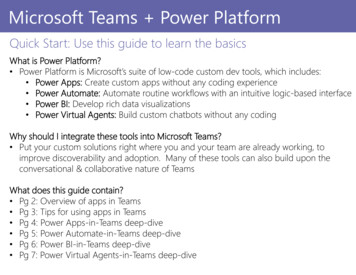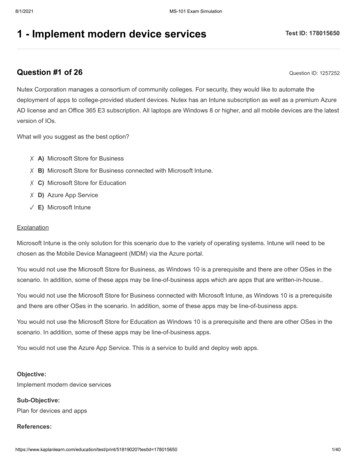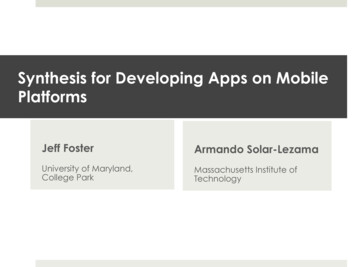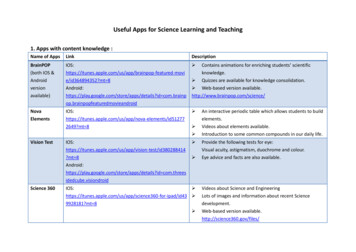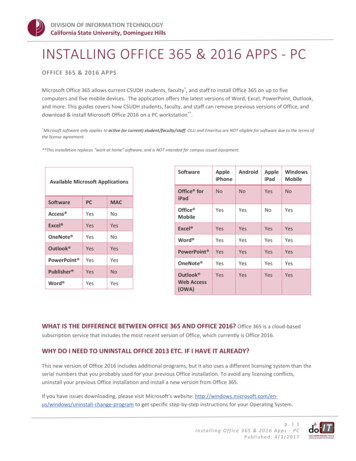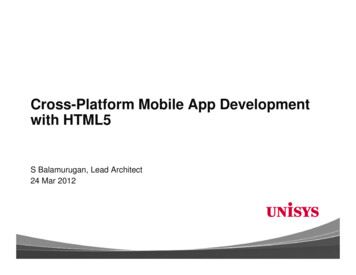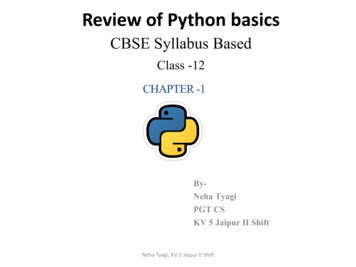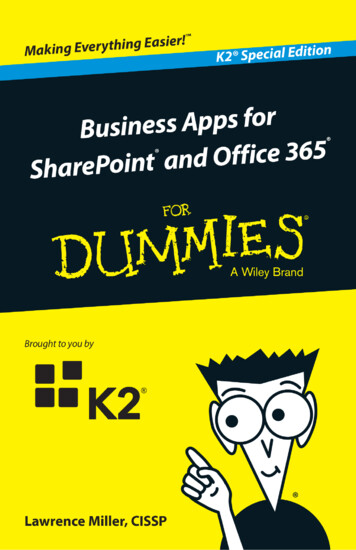
Transcription
These materials are 2016 John Wiley & Sons, Inc. Any dissemination, distribution, or unauthorized use is strictly prohibited.
Business Apps forSharePoint andOffice 365 K2 Special Editionby Lawrence Miller, CISSPThese materials are 2016 John Wiley & Sons, Inc. Any dissemination, distribution, or unauthorized use is strictly prohibited.
Business Apps for SharePoint and Office 365 For Dummies , K2 Special EditionPublished byJohn Wiley & Sons, Inc.111 River St.Hoboken, NJ 07030‐5774www.wiley.comCopyright 2016 by John Wiley & Sons, Inc., Hoboken, New JerseyNo part of this publication may be reproduced, stored in a retrieval system or transmitted in anyform or by any means, electronic, mechanical, photocopying, recording, scanning or otherwise,except as permitted under Sections 107 or 108 of the 1976 United States Copyright Act, without theprior written permission of the Publisher. Requests to the Publisher for permission should beaddressed to the Permissions Department, John Wiley & Sons, Inc., 111 River Street, Hoboken, NJ07030, (201) 748‐6011, fax (201) 748‐6008, or online at http://www.wiley.com/go/permissions.Trademarks: Wiley, For Dummies, the Dummies Man logo, The Dummies Way, Dummies.com, MakingEverything Easier, and related trade dress are trademarks or registered trademarks of John Wiley &Sons, Inc. and/or its affiliates in the United States and other countries, and may not be used withoutwritten permission. K2, the K2 four squares logo, K2 blackpearl, K2 connect, and K2 smartforms areregistered trademarks or trademarks of SourceCode Technology Holdings, Inc., in the United Statesand other countries. All other trademarks are the property of their respective owners. John Wiley &Sons, Inc., is not associated with any product or vendor mentioned in this book.LIMIT OF LIABILITY/DISCLAIMER OF WARRANTY: THE PUBLISHER AND THE AUTHOR MAKENO REPRESENTATIONS OR WARRANTIES WITH RESPECT TO THE ACCURACY ORCOMPLETENESS OF THE CONTENTS OF THIS WORK AND SPECIFICALLY DISCLAIM ALLWARRANTIES, INCLUDING WITHOUT LIMITATION WARRANTIES OF FITNESS FOR APARTICULAR PURPOSE. NO WARRANTY MAY BE CREATED OR EXTENDED BY SALES ORPROMOTIONAL MATERIALS. THE ADVICE AND STRATEGIES CONTAINED HEREIN MAY NOT BESUITABLE FOR EVERY SITUATION. THIS WORK IS SOLD WITH THE UNDERSTANDING THAT THEPUBLISHER IS NOT ENGAGED IN RENDERING LEGAL, ACCOUNTING, OR OTHER PROFESSIONALSERVICES. IF PROFESSIONAL ASSISTANCE IS REQUIRED, THE SERVICES OF A COMPETENTPROFESSIONAL PERSON SHOULD BE SOUGHT. NEITHER THE PUBLISHER NOR THE AUTHORSHALL BE LIABLE FOR DAMAGES ARISING HEREFROM. THE FACT THAT AN ORGANIZATIONOR WEBSITE IS REFERRED TO IN THIS WORK AS A CITATION AND/OR A POTENTIAL SOURCEOF FURTHER INFORMATION DOES NOT MEAN THAT THE AUTHOR OR THE PUBLISHERENDORSES THE INFORMATION THE ORGANIZATION OR WEBSITE MAY PROVIDE ORRECOMMENDATIONS IT MAY MAKE. FURTHER, READERS SHOULD BE AWARE THAT INTERNETWEBSITES LISTED IN THIS WORK MAY HAVE CHANGED OR DISAPPEARED BETWEEN WHENTHIS WORK WAS WRITTEN AND WHEN IT IS READ.For general information on our other products and services, or how to create a customFor Dummies book for your business or organization, please contact our BusinessDevelopment Department in the U.S. at 877‐409‐4177, contact info@dummies.biz,or visit www.wiley.com/go/custompub. For information about licensing theFor Dummies brand for products or services, contact BrandedRights&Licenses@Wiley.com.ISBN 978‐1‐119‐27062‐1 (pbk); ISBN 978‐1‐119‐27064‐5 (ebk)Manufactured in the United States of America10 9 8 7 6 5 4 3 2 1Publisher’s AcknowledgmentsSome of the people who helped bring this book to market include the following:Project Editor: Susan ChristophersenEditorial Manager: Rev MengleAcquisitions Editor: Katie MohrBusiness Development Representative:Karen HattanProduction Editor: Antony SamiThese materials are 2016 John Wiley & Sons, Inc. Any dissemination, distribution, or unauthorized use is strictly prohibited.
Table of ContentsIntroduction . . . . . . . . . . . . . . . . . . . . . . . . . . . . . . . . . . . . . . 1About This Book. 1Foolish Assumptions. 1Icons Used in This Book. 2Beyond the Book. 3Where to Go from Here. 3Chapter 1: Using SharePoint Apps to DeliverBusiness Value . . . . . . . . . . . . . . . . . . . . . . . . . . . . . . . . . 5Meeting the Needs of the Business. 6Staying flexible. 6Staying secure. 6Scaling across the organization. 7Moving to the cloud. 7Chapter 2: Exploring SharePoint BusinessApp Use Cases. . . . . . . . . . . . . . . . . . . . . . . . . . . . . . . . . 11Considering Common SharePoint Application Scenarios. 11Form‐based applications. 11Forms and workflow. 12Integrated business apps. 13Chapter 3: Understanding Workflows andForms in SharePoint. . . . . . . . . . . . . . . . . . . . . . . . . . . . 17Designing Forms Yourself and Creating Workflowsthat Drive Efficiency. 17Data capabilities. 18Forms and interfaces. 19Workflow design. 21Task management. 23Management and administration. 24Reporting and analytics. 26Integrating Data Across All Your Systems. 27These materials are 2016 John Wiley & Sons, Inc. Any dissemination, distribution, or unauthorized use is strictly prohibited.
ivBusiness Apps for SharePoint and Office 365 For Dummies, K2 Special Edition Chapter 4: Getting Started with BusinessApps in SharePoint and Office 365 . . . . . . . . . . . . . . . 31Thinking “Outside the Box” about SharePointand Office 365. 31Understanding Your Needs. 32Planning for the Future. 32Determining When a Third‐Party Vendor Can Help. 36Chapter 5: Ten Features to Look for ina Third‐Party SharePoint Solution. . . . . . . . . . . . . . . . 39Robust Workflow and Form Capabilities. 40Visual Tools. 40No Code Required. 41Mobile Access from Anywhere. 41Real‐time, Secure Access to LOB Data. 41Custom Reports and Audits. 42Capability to Integrate with Line‐of‐Business (LOB)Apps and Data. 43Apps that Function the Same on Premisesand in the Cloud. 43Adherence to Microsoft SharePoint Best Practices. 43A Single Product Solution. 43These materials are 2016 John Wiley & Sons, Inc. Any dissemination, distribution, or unauthorized use is strictly prohibited.
IntroductionOver the past several years, organizations of all sizes haveturned to SharePoint for their everyday portal and collaboration needs. As adoption has grown, organizations havestarted using SharePoint as a platform for business application development. According to a recent survey by Forrester,52 percent of all SharePoint customers are building, or plan tobuild, custom apps in their SharePoint environments.Although it has been common practice for some time, building custom apps in SharePoint has proven difficult, sometimesresulting in unstable SharePoint environments. To addresssome of these difficulties, Microsoft introduced the AppModel as part of its SharePoint 2013 release. The SharePointApp Model provides a framework for building customSharePoint apps while still maintaining the integrity of anorganization’s SharePoint environment.The App model provides some great capabilities, but manyapp developers find it difficult to use and are still searchingfor a better way to build apps.About This BookThis book explains common challenges encountered whenbuilding SharePoint business apps, what the implicationsare, and best practices for finding a solution that can makeapp development within SharePoint more successful for yourorganization.Foolish AssumptionsIt has been said that most assumptions have outlived theiruselessness, but I assume a few things nonetheless.These materials are 2016 John Wiley & Sons, Inc. Any dissemination, distribution, or unauthorized use is strictly prohibited.
2Business Apps for SharePoint and Office 365 For Dummies, K2 Special Edition Mainly, I assume that you are a line-of-business (LOB) manager or department head in an organization of somesort — perhaps a small or medium business, large enterprise,nonprofit, or military or government agency. This book istherefore written primarily for nontechnical readers whodon’t necessarily work in an IT department. If you are in theIT department, I assume that you are supporting an LOB manager in your business.I also assume that you’re currently using Microsoft SharePointand/or Microsoft Office 365 in your organization but are struggling to create easy-to-use business apps that will automatecommon workflows and forms, and help your various teamsand departments be more productive in their daily workactivities.If the preceding assumptions describe you, this book isfor you!Icons Used in This BookThroughout this book, I occasionally use special icons to callattention to important information. Here’s what to expect:This icon points out information that you should commit toyour nonvolatile memory, your gray matter, or your noggin —along with anniversaries and birthdays.You won’t find a map of the human genome here, but if youseek to attain the seventh level of NERD-vana, perk up! Thisicon explains the jargon beneath the jargon.Thank you for reading, I hope you enjoy the book, and pleasetake care of your writer! Seriously, this icon points out helpfulsuggestions and useful nuggets of information.This icon points out the stuff your mother warned you about.Okay, probably not. But you should take heed nonetheless —you might just save yourself some time and frustration.These materials are 2016 John Wiley & Sons, Inc. Any dissemination, distribution, or unauthorized use is strictly prohibited.
Introduction3Beyond the BookI can cover only so much in 48 short pages, so if you find yourself at the end of this book thinking, “Gosh, this was an amazing book, where can I learn more?” just go to www.k2.com.Where to Go from HereWith my apologies to Lewis Carroll, Alice, and theCheshire cat:“Would you tell me, please, which way I ought to go fromhere?”“That depends a good deal on where you want to get to,” saidthe Cat — er, the Dummies Man.“I don’t much care where . . . ,” said Alice.“Then it doesn’t matter which way you go!”That’s certainly true of Business Apps for SharePoint and Office365 For Dummies, which, like Alice in Wonderland, is also destined to become a timeless classic!If you don’t know where you’re going, any chapter will getyou there — but Chapter 1 might be a good place to start.However, if you see a particular topic that piques your interest, feel free to jump ahead to that chapter. Each chapter isindividually wrapped (but not packaged for individual sale)and written to stand on its own, so feel free to start readinganywhere and skip around to your heart’s content. Read thisbook in any order that suits you (though I don’t recommendupside down or backwards).I promise you won’t get lost falling down the rabbit hole!These materials are 2016 John Wiley & Sons, Inc. Any dissemination, distribution, or unauthorized use is strictly prohibited.
4Business Apps for SharePoint and Office 365 For Dummies, K2 Special Edition These materials are 2016 John Wiley & Sons, Inc. Any dissemination, distribution, or unauthorized use is strictly prohibited.
Chapter 1Using SharePoint Apps toDeliver Business ValueIn This Chapter Building better apps to support the business Adapting at the speed of business Keeping your data safe Supporting business growth Migrating from on-premises to the cloudWhen Microsoft SharePoint Portal Server was introduced back in 2001, it focused mainly on providinga document management and collaboration portal. Over thepast decade and a half, SharePoint has grown to be muchmore, with many users viewing it as a web application platform. With the introduction of the SharePoint App Model,SharePoint 2013 became a more complete web applicationplatform, allowing developers to build web-based applicationsserved up through the SharePoint interface. Subsequently,there has been a rise in the number of organizations turningto SharePoint for their application needs.In this chapter, you learn how SharePoint-based apps candeliver significant value to your organization.These materials are 2016 John Wiley & Sons, Inc. Any dissemination, distribution, or unauthorized use is strictly prohibited.
6Business Apps for SharePoint and Office 365 For Dummies, K2 Special Edition Meeting the Needsof the BusinessAs organizations embrace SharePoint as a core technologyfor their business, SharePoint users have found that theapps they are building need to do more. In fact, the rise ofthe “bring your own app” (BYOA) trend is making it increasingly difficult for IT departments to implement business appsand tools that will be used. Whether that means includingadditional business logic or providing a more intuitive userinterface, meeting the business’s needs without turning tosoftware code is getting harder. By using SharePoint’s outof-the-box application platform capabilities along with thirdparty SharePoint add-ins to fill in the gaps, companies canbuild applications that meet users’ needs while keeping development time and costs down.Staying flexibleBusiness is moving more quickly than ever, and organizationsneed to be agile enough to quickly adapt to changes. Withmore businesses running critical apps in their SharePointenvironment, it’s important to be able to build apps that canadapt quickly as well. SharePoint-based apps provide a wayto keep up with rapidly changing business needs while stillproviding easy-to-use tools that don’t require a lot of customdevelopment time.Staying secureSecurity breaches in organizations that handle consumer dataare occurring far too often. Even if your company doesn’thandle large quantities of sensitive information, you need tomake sure that your SharePoint applications are secure. Withthird-party integration options that provide real-time, secureaccess to line-of-business (LOB) data, you can combine all thebenefits of a SharePoint app with integration points that aresecure, regardless of where your information resides.These materials are 2016 John Wiley & Sons, Inc. Any dissemination, distribution, or unauthorized use is strictly prohibited.
Chapter 1: Using SharePoint Apps to Deliver Business Value7Scaling across the organizationMany companies start small with their SharePoint app development, but it doesn’t take long for the rest of the organization to jump onboard, especially if the apps are built well.Having SharePoint used across departments in organizationsof all sizes provides a great way to roll out applications acrossthe entire organization without the need for a lot of additionaltraining. Third-party additions can help ensure scalability andperformance across all your applications, no matter how bigthey may be.Moving to the cloudYour organization may not be moving to the cloud yet,but it’s bound to happen at some point. According torecent cloud computing research by the New JerseyInstitute of Technology, 73 percent of the world’s data willreside in the cloud within the next two years (http:// s-infographics/security-of-cloud-services/),and according to AIIM’s most recent survey of SharePointusers, 34 percent of organizations are planning to moveto SharePoint Online (a cloud-based service hosted byMicrosoft) for at least some of their content earch/Industry-Watch/SharePoint-2015).To ensure that you have access to all the information yourusers need to make proper decisions, your apps need to bebuilt to integrate with your data regardless of where it lives.With new capabilities being added to SharePoint 2016, running a hybrid environment that spans on-premises and cloudenvironments will help ensure that your applications runseamlessly no matter where they are.Lack of feature parity between on-premises and cloud-basedSharePoint environments may mean additional implementation challenges for many organizations that are moving tothe cloud, but third-party tools can help ensure a smooth transition.These materials are 2016 John Wiley & Sons, Inc. Any dissemination, distribution, or unauthorized use is strictly prohibited.
8Business Apps for SharePoint and Office 365 For Dummies, K2 Special Edition Improved case managementwith K2 and SharePointKeoghs is one of the leading providers of claims-related servicesto insurers, businesses, and othersuppliers to the insurance sector. Itcombines proven processes, technology, and a low-cost infrastructure with deep legal and insurancemarket knowledge. This combinationenables Keoghs to create individualsolutions for each client that matchthe client’s requirements in terms ofquality, performance, and value formoney.The legal services market in theUnited Kingdom is experiencingrapid change as a result of forcesthat include market consolidation, globalization, and regulatorychange leading to greater corporatization, new legal structures, andan increased role for technology.As a forward thinker, Keoghs recognized the need to transform its business early to support its specialistteams and drive efficiencies throughadvanced technology.As had many of its peers, Keoghshad implemented a Windows clientbased legal case management solution in the past. As the firm’s need toaccelerate processes increased, thissolution had become a rusty ball andchain, preventing rapid changes andlimiting Keoghs’s ability to scale tomeet customer demands.When looking for a replacementsolution, Keoghs, which refers toitself as a nonconventional lawfirm, had several requirements thatgeneral law-firm-oriented case- management systems couldn’t meet.Keoghs’s focus on complex insurance claims, together with industrychanges, required a level of processexcellence typically associatedwith advanced business-process- management tools. These factors ledKeoghs to choose a solution basedon K2 and SharePoint.SolutionSlicedbread was selected asthe preferred partner by Keoghsto implement a single case- management solution, based onSlicedbread’s previous experienceimplementing large-scale claimscase- management solutions usingK2 and SharePoint. The solution,named Tracker, formed Keoghs’smain business application, running95 percent of all its critical processesfrom case management to productdevelopment and client reporting.Slicedbread’s experience helpedKeoghs reduce risk and accelerateimplementation.Tracker combined the power ofSharePoint (across documentmanagement, unified desktop, collaboration, and analytics) with K2(to manage and optimize businessprocesses and increase overallbusiness maintainability), and QorusDocGeneration.These materials are 2016 John Wiley & Sons, Inc. Any dissemination, distribution, or unauthorized use is strictly prohibited.
Chapter 1: Using SharePoint Apps to Deliver Business ValueDesigned to empower case handlersto coordinate, advocate, escalate,document, track, and report acrosstheir case portfolios, Tracker willenable caseworkers to make intelligent predictable judgments on casesand work allocation based on solidempirical evidence.more than simply tracking to-dos,watching a calendar, and keepinga file of notes, the future of Trackeris to be truly dynamic — we have avision of it knowing exactly what hasbeen done and being able to handleanything that might be next, even ifit’s not ‘what’s next’ on paper.”The solution also supports Keoghs’slean principles, including:Benefits Reducing activities that add noclient value Streamlined core processesincluding due diligence, drafting,negotiation, and risk assessment Supporting adaptive case management Reduced process “waste” andincreased billable hours Empowering and guiding, ratherthan leading and preventing More efficient allocation ofresources, improved quality, andmore intelligent decision-making Favoring visualization ratherthan escalations Reducing IT bottlenecks toprocess management/processimprovement9 Quick adaptation of Keoghs’sprocesses to meet clients’needs, enabling them to be moreprice competitive and responsiveJohn Salt, Chief Information Officerat Keoghs, says, “Delivering so muchThese materials are 2016 John Wiley & Sons, Inc. Any dissemination, distribution, or unauthorized use is strictly prohibited.
10Business Apps for SharePoint and Office 365 For Dummies, K2 Special Edition These materials are 2016 John Wiley & Sons, Inc. Any dissemination, distribution, or unauthorized use is strictly prohibited.
Chapter 2Exploring SharePointBusiness App Use CasesIn This Chapter Managing data with intuitive, forms‐based apps Using workflows that drive efficiency across your entire business Working with integrated business appsIn this chapter, you learn about common usage scenariosfor forms, workflows, and business apps in SharePoint.Considering Common SharePointApplication ScenariosWith the introduction of new capabilities and features on theSharePoint platform, users are building all types of SharePoint‐based applications, ranging from simple, department‐focuseddocument approval workflows to mission‐ critical businessapplications that span an entire organization.Despite that variety, some application types are better suitedto SharePoint than others. Industry analysts like Gartner andothers see the following application scenarios most often.Form‐based applicationsSharePoint is often used as a repository for gathering data, soit’s no surprise that many SharePoint users are interested increating forms applications that can be used to easily gatheror update information within a SharePoint list or library.These materials are 2016 John Wiley & Sons, Inc. Any dissemination, distribution, or unauthorized use is strictly prohibited.
12Business Apps for SharePoint and Office 365 For Dummies, K2 Special Edition As an example, consider a common use case involving anemployee suggestion box. Robert, the CEO of a mid‐sizedmanufacturing company, encouraged all his employees tosend him suggestions on actions the company can take toimprove. His employees weren’t shy about providing suggestions and often emailed him or even jotted down ideas onsticky notes, which were then hand‐delivered to Madeleine,Robert’s assistant.Robert had a hard time keeping track of all the ideas anddidn’t have a good prioritization system or even a way toeasily update the company when an idea was implemented.Madeleine used the company’s SharePoint site to keep trackof many of her projects, and she suggested that implementing a suggestion box within SharePoint might solve Robert’sproblem. Madeleine created a simple SharePoint list to storethe suggestion information and included fields for priorityand status. She added a form to the home page of the site thatallowed users to add new suggestions and, using SharePoint’sout‐of‐the‐box web parts, created a dashboard page that gaveeveryone the capability to view new submissions, check onthe status of ideas they submitted, and even vote on theirfavorite ideas.With the centralized system for keeping track of suggestions,Robert could focus on getting more of his employees’ ideasimplemented and saw significant improvements in the organization’s day‐to‐day operations. He also planned to look atother forms‐based applications to implement in SharePoint,including an employee satisfaction survey and an asset‐ tracking system.Forms and workflowApplications in this category include forms for gatheringand updating information as well as workflow to handle thatdata in some way. Approval workflows are the most commonuse case in this category and include applications like leaverequests, policy approvals, and service‐ticket requests.Sarah, an HR specialist, was looking for a new way for heremployees to submit leave requests for approval. She wantedapprovals to be assigned to the appropriate HR person inThese materials are 2016 John Wiley & Sons, Inc. Any dissemination, distribution, or unauthorized use is strictly prohibited.
Chapter 2: Exploring SharePoint Business App Use Cases13each of her company’s regional offices. She wants to make iteasy for employees to track their requests.Working with James, a business analyst in the IT department,Sarah created a SharePoint workflow to handle leave requests,which were added to a SharePoint list. Using SharePoint’sintegration with Active Directory, Sarah automatically pulledin the correct approver information based on the region of theemployee submitting the request. The workflow that Jamesadded directed a task to the appropriate HR person, whocould quickly approve or decline the request. Upon completion of the process, the requesting employee received anemail providing real-time updates on the status of the request.Sarah also created some reports using the information in theleave‐request list, allowing her to track the different typesof leave being requested and to look for trends across eachregion.With the introduction of the new leave‐request system,Sarah has seen a decrease in the number of last‐minute leaverequests and has received lots of positive feedback fromemployees who are excited about the improved visibility therequest system gives them.Integrated business appsThe final category of applications commonly built inSharePoint consists of more advanced form and workflowapplications that span one or more other systems outsideSharePoint. These applications may use SharePoint as theentry point because of its familiar end‐user interface, butoften need to surface data from other systems or connectdirectly to the system to create or update new or existinginformation. Use cases in this category tend to be either organization‐wide or mission‐critical applications.As an example, consider a customer help‐desk scenario.A large software company was looking for a new help‐deskpackage to replace its old, custom‐developed solution. Hana,the IT project manager in charge of the project, had troublefinding a solution that met all the company’s requirements.Not only did the solution need to handle common help‐deskneeds such as escalations, it also needed to integrate with theThese materials are 2016 John Wiley & Sons, Inc. Any dissemination, distribution, or unauthorized use is strictly prohibited.
14Business Apps for SharePoint and Office 365 For Dummies, K2 Special Edition company’s customer relationship management (CRM) platform and provide an interface that didn’t require a lot of training for the busy help‐desk staff.During a project meeting, someone on Hana’s team suggestedlooking at developing a SharePoint‐based application thatcould meet all the company’s requirements. Hana knew thatSharePoint offered some line‐of‐business integration capabilities as well as a workflow engine that she thought couldhandle their ticket‐routing needs. Gail, the help‐desk supervisor, was also excited about the idea because her team alreadyused SharePoint on a daily basis to keep track of vacation andinternal project tasks.Hana decided to put together a team to build a quick proofof concept (POC) so that they could verify some of the mostcritical requirements. Her IT team was experienced withSharePoint and its capabilities, so the team could quicklybuild an application that covered the majority of their requirements.Gail and her team were impressed with the system and couldstart using it immediately because the interface was alreadyfamiliar to staff. Gail quickly saw an improvement in the speedin which tickets were handled, and she noticed a decrease inthe number of ticket escalations, in part because of the customer contract information to which her support engineershad direct access.Video game maker uses K2 businessapps to maintain controlAction‐laden games like TombRaider and Hitman have helpedto make Square Enix one of the biggest names in digital entertainment. Gaming enthusiasts aroundthe world eagerly await news of upcoming releases, and the companyhas to work hard to keep its plans topsecret. Even internal requests to seegames in development must be verycarefully managed to prevent thelatest plots and graphics from fallinginto the wr
ing custom apps in SharePoint has proven difficult, sometimes resulting in unstable SharePoint environments. To address some of these difficulties, Microsoft introduced the App Model as part of its SharePoint 2013 release. The SharePoint App Model provides a framework for building custom SharePoint

